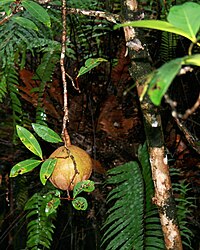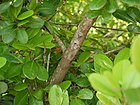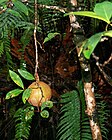Note: This is a project under development. The articles on this wiki are just being initiated and broadly incomplete. You can Help creating new pages.
Difference between revisions of "Xylocarpus granatum"
(Created page with "{{stub}} ==Uses== {{Uses|}}, {{Uses|}}, {{Uses|}}, {{Uses|}}, {{Uses|}}, {{Uses|}}, {{Uses|}}, {{Uses|}}, {{Uses|}}, {{Uses|}}, {{Uses|}}.<ref name="Uses"/> ==Parts Used== {{...") |
|||
| (8 intermediate revisions by the same user not shown) | |||
| Line 1: | Line 1: | ||
| − | + | [[File:Xylocarpus granatum.jpg|200px|thumb|right]] | |
| + | |||
| + | '''Xylocarpus granatum''' is a shrub or tree that can grow from 5 to 15 metres tall, exceptionally to 20 metres. It has well-developed buttresses and an elaborated above ground root system. It can reach a diameter of up to 100cm. The plant is usually evergreen, though in some areas with seasonal climates it can become briefly deciduous. The tree is utilised locally for its timber, tannins and medicinal properties. | ||
==Uses== | ==Uses== | ||
| − | {{Uses|}}, {{Uses|}}, {{Uses|}}, {{Uses| | + | {{Uses|Swellings}}, {{Uses|Dysentery}}, {{Uses|Diarrhoea}}, {{Uses|Itchy skin}}.<ref name="Uses"/> |
==Parts Used== | ==Parts Used== | ||
| − | {{Parts Used|}}, {{Parts Used| | + | {{Parts Used|Fruits}}, {{Parts Used|Bark}}, {{Parts Used|Seeds}}. |
==Chemical Composition== | ==Chemical Composition== | ||
| − | <ref name="chemical composition"/> | + | Ten compounds were isolated from the fruit of Xylocarpus granatum and the structures of them were identified as spicatin, xyloccensin, 6-acetoxycedrodorin, aurantiamide acetate etc.<ref name="chemical composition"/> |
==Common names== | ==Common names== | ||
| − | {{Common names|sa=|en=|gu=|hi=|kn=|ks=|ml=|mr=|pa=|ta=|te=}} | + | {{Common names|sa=|en=Cannonball Mangrove|gu=|hi=|kn=|ks=|ml=|mr=Karpa|pa=|ta=Conmuntiri|te=Chenuga}} |
==Properties== | ==Properties== | ||
| Line 16: | Line 18: | ||
===Dravya=== | ===Dravya=== | ||
===Rasa=== | ===Rasa=== | ||
| − | |||
===Guna=== | ===Guna=== | ||
| Line 29: | Line 30: | ||
==Habit== | ==Habit== | ||
| − | {{Habit|}} | + | {{Habit|Evergreen tree}} |
==Identification== | ==Identification== | ||
| Line 48: | Line 49: | ||
==Mode of Propagation== | ==Mode of Propagation== | ||
| − | {{Propagation|}} | + | {{Propagation|Seeds}} |
==How to plant/cultivate== | ==How to plant/cultivate== | ||
| − | <ref name="How to plant/cultivate"/> | + | A plant of the wet lowland tropics. It grows best in areas where annual daytime temperatures are within the range 22 - 30°c, but can tolerate 10 - 40°c.<ref name="How to plant/cultivate"/> |
==Commonly seen growing in areas== | ==Commonly seen growing in areas== | ||
| − | {{Commonly seen| | + | {{Commonly seen|Found in tidal mud of mangrove swamps}}. |
==Photo Gallery== | ==Photo Gallery== | ||
| − | <gallery class="left" caption="" widths="140px" heights="140px"> | + | <gallery class="left" caption="" widths="140px" heights="140px"> |
| + | Xylocarpus granatum (5929385514).jpg | ||
| + | |||
| + | |||
| + | Xylocarpus granatum (5929387514).jpg | ||
| + | |||
| + | |||
| + | Xylocarpus granatum (5929395924).jpg | ||
| + | |||
| + | |||
| + | Xylocarpus granatum.jpg | ||
| + | |||
</gallery> | </gallery> | ||
| Line 64: | Line 76: | ||
<references> | <references> | ||
| − | <ref name="chemical composition">[ | + | <ref name="chemical composition">[https://pubmed.ncbi.nlm.nih.gov/19960941/#:~:text=Results%3A%20Ten%20compounds%20were%20isolated,)%20and%20ethyl%203%2C4%2D Chemical constituents]</ref> |
| − | <ref name="Leaf">[ | + | <ref name="Leaf">[Morphology]</ref> |
| − | <ref name="How to plant/cultivate">[ | + | <ref name="How to plant/cultivate">[http://tropical.theferns.info/viewtropical.php?id=Xylocarpus+granatum Cultivation details]</ref> |
<ref name="Uses">Indian Medicinal Plants by C.P.Khare</ref> | <ref name="Uses">Indian Medicinal Plants by C.P.Khare</ref> | ||
</references> | </references> | ||
==External Links== | ==External Links== | ||
| − | * [ ] | + | * [https://www.flowersofindia.net/catalog/slides/Cannonball%20Mangrove.html#:~:text=Xylocarpus%20granatum%20%2D%20Cannonball%20Mangrove&text=Cannonball%20Mangrove%20is%20a%20small,pointed%20base%20and%20rounded%20tip. Xylocarpus granatum on flowersofindia.net] |
| − | * [ ] | + | * [https://uses.plantnet-project.org/en/Xylocarpus_granatum_(PROTA) Xylocarpus granatum on plant net-project.org] |
| − | + | ||
[[Category:Herbs]] | [[Category:Herbs]] | ||
Latest revision as of 20:03, 4 September 2020
Xylocarpus granatum is a shrub or tree that can grow from 5 to 15 metres tall, exceptionally to 20 metres. It has well-developed buttresses and an elaborated above ground root system. It can reach a diameter of up to 100cm. The plant is usually evergreen, though in some areas with seasonal climates it can become briefly deciduous. The tree is utilised locally for its timber, tannins and medicinal properties.
Contents
- 1 Uses
- 2 Parts Used
- 3 Chemical Composition
- 4 Common names
- 5 Properties
- 6 Habit
- 7 Identification
- 8 List of Ayurvedic medicine in which the herb is used
- 9 Where to get the saplings
- 10 Mode of Propagation
- 11 How to plant/cultivate
- 12 Commonly seen growing in areas
- 13 Photo Gallery
- 14 References
- 15 External Links
Uses
Swellings, Dysentery, Diarrhoea, Itchy skin.[1]
Parts Used
Chemical Composition
Ten compounds were isolated from the fruit of Xylocarpus granatum and the structures of them were identified as spicatin, xyloccensin, 6-acetoxycedrodorin, aurantiamide acetate etc.[2]
Common names
| Language | Common name |
|---|---|
| Kannada | |
| Hindi | |
| Malayalam | |
| Tamil | Conmuntiri |
| Telugu | Chenuga |
| Marathi | Karpa |
| Gujarathi | |
| Punjabi | |
| Kashmiri | |
| Sanskrit | |
| English | Cannonball Mangrove |
Properties
Reference: Dravya - Substance, Rasa - Taste, Guna - Qualities, Veerya - Potency, Vipaka - Post-digesion effect, Karma - Pharmacological activity, Prabhava - Therepeutics.
Dravya
Rasa
Guna
Veerya
Vipaka
Karma
Prabhava
Habit
Identification
Leaf
| Kind | Shape | Feature |
|---|---|---|
Flower
| Type | Size | Color and composition | Stamen | More information |
|---|---|---|---|---|
| {{{5}}} |
Fruit
| Type | Size | Mass | Appearance | Seeds | More information |
|---|---|---|---|---|---|
Other features
List of Ayurvedic medicine in which the herb is used
Where to get the saplings
Mode of Propagation
How to plant/cultivate
A plant of the wet lowland tropics. It grows best in areas where annual daytime temperatures are within the range 22 - 30°c, but can tolerate 10 - 40°c.[4]
Commonly seen growing in areas
Found in tidal mud of mangrove swamps.
Photo Gallery
References
- ↑ Indian Medicinal Plants by C.P.Khare
- ↑ Chemical constituents
- ↑ [Morphology]
- ↑ Cultivation details
External Links
- Ayurvedic Herbs known to be helpful to treat Swellings
- Ayurvedic Herbs known to be helpful to treat Dysentery
- Ayurvedic Herbs known to be helpful to treat Diarrhoea
- Ayurvedic Herbs known to be helpful to treat Itchy skin
- Herbs with Fruits used in medicine
- Herbs with Bark used in medicine
- Herbs with Seeds used in medicine
- Herbs with common name in Tamil
- Herbs with common name in Telugu
- Herbs with common name in Marathi
- Herbs with common name in English
- Habit - Evergreen tree
- Index of Plants which can be propagated by Seeds
- Herbs that are commonly seen in the region of Found in tidal mud of mangrove swamps
- Herbs




